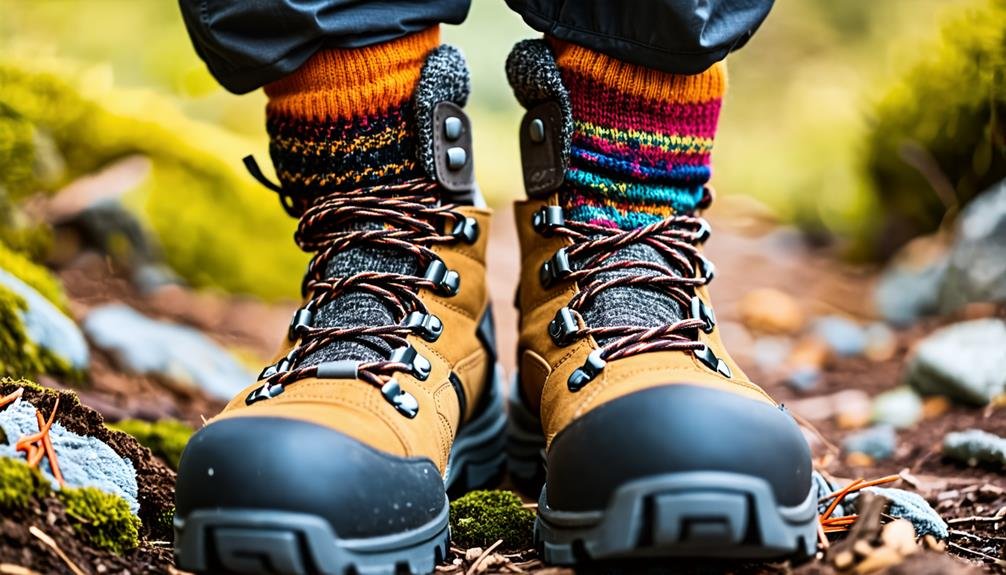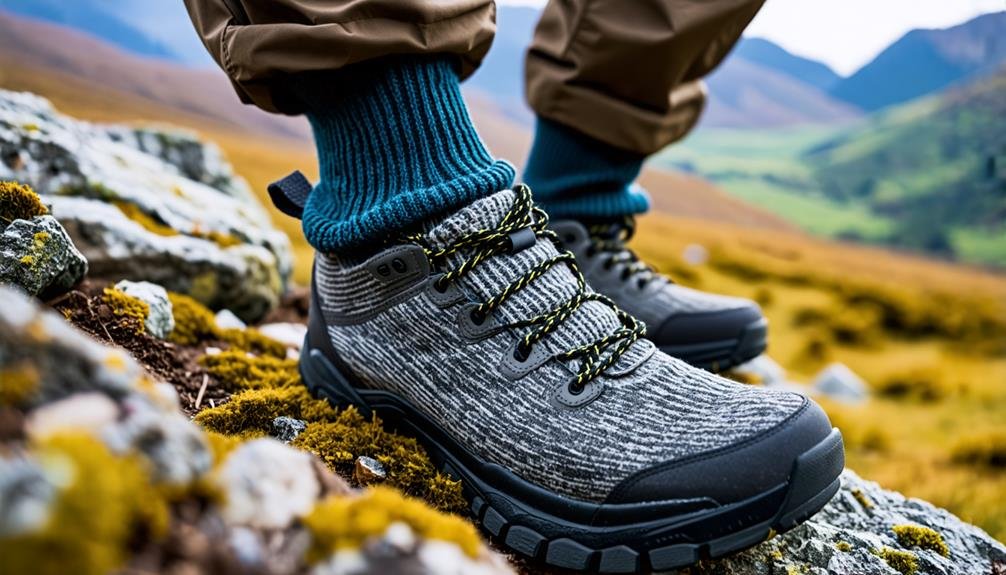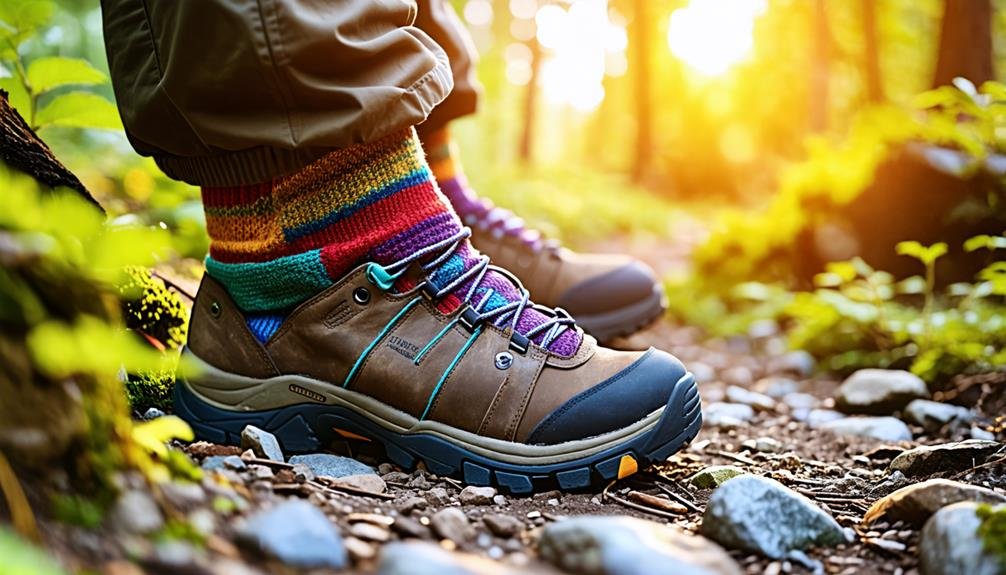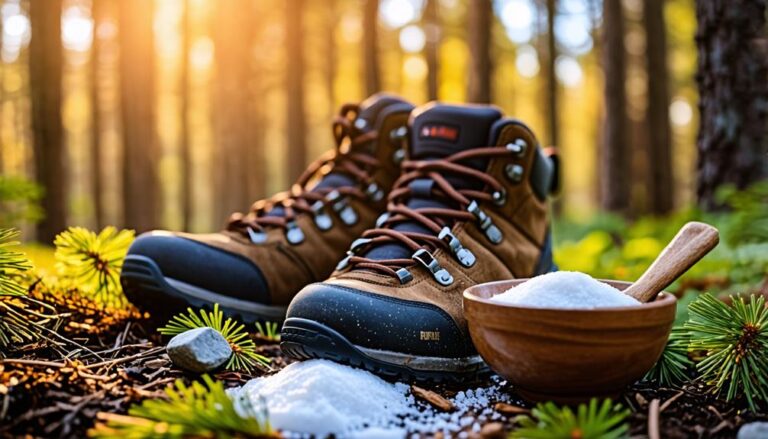Experienced hikers wear two pairs of socks to optimize comfort and reduce the risk of blisters. The inner sock, made of moisture-wicking fabric, keeps feet dry by drawing sweat away from the skin. The outer sock provides additional cushioning and support, minimizing friction against hiking boots. This combination reduces hotspots that can cause blisters, especially on long treks across rugged terrain. However, in hot weather, a single pair of high-quality socks may be more suitable. A proper fit for shoes is crucial, as it affects comfort. Exploring further reveals additional tips and techniques for an enjoyable hiking experience.
Benefits of Double Socks
Wearing double pairs of socks can significantly enhance comfort and lower the chances of blisters during extended outdoor adventures. The two layers work together to reduce friction between your feet and hiking boots. Many seasoned trekkers advocate for this method, reporting an improved overall experience on the trails. The outer layer, often made from brands like Smartwool or Darn Tough, provides additional cushioning that helps tackle rocky or uneven surfaces. This extra padding absorbs impact and supports your feet, allowing you to explore freely without the nagging discomfort of blisters.
Additionally, pairing high-performance hiking socks with suitable footwear ensures that your feet stay dry and comfortable throughout long excursions. This combination is especially advantageous on lengthy hikes, where each step is crucial. A well-fitted outer sock complements a moisture-wicking inner sock, creating a shield against sweat and friction. Hiking guides frequently highlight the significance of selecting socks that fit properly, as it can greatly enhance your trekking experience. By embracing the double sock strategy, you can fully enjoy the wonders of the outdoors while minimizing discomfort, allowing you to appreciate the beauty of nature without being distracted by foot pain.
Reducing Friction and Blisters
The two-sock strategy effectively minimizes friction and prevents blisters, as the combination of two layers creates a barrier that reduces direct contact between the foot and the footwear. When wearing two pairs of socks, the inner sock moves with the foot, while the outer sock slides against the shoe. This sliding action decreases the friction that often leads to blisters, making it essential for anyone seeking comfort on hiking trails.
Selecting the right hiking equipment is crucial for this method to work effectively. The inner sock should be crafted from moisture-wicking fabric, such as those offered by brands like Smartwool or Darn Tough, to maintain dryness, while the outer sock can provide extra cushioning. This combination not only prevents blisters but also supports overall foot health during extended hikes.
It's vital to ensure that both socks fit comfortably within the hiking boots, as a snug fit can cause discomfort. Seasoned hikers often advocate for this two-sock system, particularly when navigating rocky or uneven terrains. By investing in high-quality hiking gear from reputable brands and utilizing the two-sock technique, adventurers can embark on their journeys with greater assurance, knowing they are taking proactive measures against painful blisters.
Enhanced Cushioning for Comfort

How does enhanced cushioning from the two-sock method elevate comfort during long hikes? Utilizing two pairs of socks provides an additional layer of padding that significantly alleviates pressure on your feet. The outer layer, such as a Smartwool or Darn Tough sock, delivers extra cushioning, which is particularly beneficial for extended journeys across rugged or uneven terrain. This supplementary padding absorbs shock, making each stride feel gentler and less jarring.
Moreover, the two-sock strategy reduces direct contact between your feet and the interior of your hiking boots, like those from Merrell or Salomon. This separation minimizes the risk of painful hotspots, allowing you to immerse yourself in the adventure rather than fretting over discomfort. Seasoned hikers often report that this technique enhances their overall trekking experience, enabling them to cover greater distances without the lingering pain associated with a single pair of socks.
Considerations for Hot Weather
In hot weather, the two-sock method can cause discomfort and excessive moisture, making it crucial to assess its effectiveness for your hiking trip. As temperatures rise, your feet are more likely to sweat. This perspiration can build up between the socks, leading to a damp space that may cause blisters instead of preventing them.
When trekking in warm regions, focus on the fabric of your socks. Lightweight, moisture-wicking materials like Coolmax can help maintain dryness, and you might discover that a single pair of high-quality socks, such as those from Smartwool or Darn Tough, is more advantageous than two pairs. Additionally, consider your footwear. Shoes with good ventilation, such as those from Merrell or Salomon, can significantly help in managing heat and moisture.
If you opt for the two-sock method, be ready to swap out socks during your hike. This can rejuvenate your feet and lessen discomfort. Remember, your feet may swell during extended hikes, and wearing two pairs of socks might feel constricting. Ultimately, find a balance between comfort and breathability to ensure your hiking experience is pleasant and unrestricted.
Proper Fit for Hiking Shoes

Choosing the right fit for your hiking shoes is crucial for comfort and performance. It's vital to make sure that your shoes are the correct size and can accommodate the thickness of two pairs of socks without feeling too tight. For example, if your hiking boots are snug with one pair of socks, adding another may lead to discomfort, especially during long hikes when your feet may swell.
Importance of Shoe Size
Selecting the right size of hiking footwear is essential for maintaining comfort and avoiding injuries during extended outdoor adventures. While trekking, feet can expand, particularly after several hours of movement. Shoes that fit too snugly can lead to discomfort and blisters, while those that are too loose can result in instability and slipping. Therefore, prioritizing the correct shoe size is vital.
To find your perfect fit, consider trying on outdoor shoes in the evening when your feet are slightly swollen. Always wear the hiking socks you intend to use, as their thickness can affect the fit. Ensure there is adequate space in the toe area to wiggle your toes, and that your heel fits snugly without rising.
Sock Thickness Compatibility
Choosing the right sock thickness is essential for ensuring a comfortable fit in your hiking boots, as it significantly influences your overall comfort, performance, and foot health during outdoor adventures. When picking socks, consider the thickness of both the base and the outer layers. A lightweight base sock made from moisture-wicking fabrics, like Smartwool or Darn Tough, aids in keeping your feet dry, while a heavier outer sock provides cushioning and warmth, enhancing your experience on the trail. This allows you to appreciate the natural beauty around you without the distraction of discomfort.
Ensure that your hiking boots, such as Merrell or Salomon, can accommodate two pairs of socks without feeling too tight. If your boots are already snug, you may need to opt for thinner socks to prevent restricted blood flow or discomfort. Additionally, take the climate into account; lightweight socks are ideal for warm weather, while thicker options are preferable in cooler temperatures. Remember, your feet may swell during extended hikes, so it's vital to maintain a comfortable fit throughout your journey. By carefully selecting sock thickness, you can explore the outdoors freely, avoiding painful blisters and cramped feet.
Managing Sweat and Moisture
Managing sweat and moisture is vital for a comfortable hiking experience. Using moisture-wicking materials in your socks can help keep your feet dry by drawing sweat away from the skin, while regularly changing socks can prevent dampness from building up. Furthermore, selecting socks with good breathability will improve airflow, reducing the risk of blisters and discomfort during your hike.
Moisture-Wicking Materials
Moisture-wicking fabrics, such as those found in brands like Smartwool and Darn Tough, play a crucial role in keeping feet dry by effectively drawing sweat away from the skin. These specialized textiles, often crafted from synthetic fibers like polyester or nylon, pull moisture away from your skin and transport it to the outer layer of the sock. This moisture management helps reduce the risk of blisters and discomfort, allowing outdoor enthusiasts to focus on the beauty of nature instead of foot pain.
Moreover, moisture-wicking socks are typically lightweight and breathable, which is essential for maintaining a comfortable temperature inside hiking boots. When feet can breathe, they are less likely to overheat, preventing excessive sweating. For instance, a hiker using a pair of moisture-wicking socks from Balega during a challenging trek will discover that their feet remain dry and less susceptible to irritation.
Ultimately, investing in high-quality moisture-wicking materials is a wise choice for anyone who enjoys exploring the outdoors. By keeping feet dry and comfortable, these innovative fabrics enable adventurers to embark on their journeys without the distraction of sweaty socks.
Sock Changing Techniques
Changing socks regularly during a hiking adventure can greatly enhance foot comfort by addressing moisture buildup and minimizing the chances of blisters. When you notice dampness inside your hiking boots, it's essential to pause and replace your socks. This straightforward action can refresh your feet and help maintain the freedom you seek on the trails.
To effectively manage perspiration, consider packing at least one additional pair of high-performance moisture-wicking socks, such as those made by brands like Smartwool or Darn Tough. When you change socks, ensure your feet are thoroughly dried, particularly in the areas between your toes, to prevent blisters from friction and moisture.
Additionally, aim to time your sock changes during rest stops, allowing your feet to air out. If you sense that your feet are becoming excessively hot or sweaty, seize the moment to swap socks even if you haven't reached your scheduled break.
Ultimately, being proactive about moisture control will keep you comfortable and enable you to enjoy the wonders of nature. By integrating sock changing techniques into your hiking routine, you can immerse yourself in the experience and appreciate the stunning scenery that surrounds you.
Breathability Considerations
Breathability in hiking footwear is crucial for preventing sweat buildup and ensuring comfort during extended outdoor excursions. When feet perspire, moisture can accumulate inside socks and shoes, resulting in discomfort and potential foot issues. Wearing two pairs of socks can help manage moisture effectively. The inner sock, often crafted from moisture-wicking materials like Coolmax, pulls sweat away from the skin, while the outer sock adds an extra layer against external elements.
Selecting appropriate materials is essential. Opt for socks made from breathable fabrics such as merino wool or high-performance synthetic blends from brands like Smartwool or Darn Tough. These materials facilitate air circulation, rapidly evaporating sweat. Additionally, ensuring proper ventilation in hiking boots, such as those from Salomon or Merrell, enhances overall breathability and minimizes dampness.
However, assess weather conditions prior to choosing double socks. In hot or humid environments, a single pair may offer greater comfort. Always verify that your footwear fits correctly, as snug shoes can impede airflow and contribute to overheating. By emphasizing breathability, you can fully enjoy your hiking adventures without the discomfort of damp feet.
Learning From Other Athletes

Athletes from various sports, including runners and soccer players, frequently use the double-sock strategy to enhance comfort and reduce foot injury risk during rigorous activities. This technique has demonstrated effectiveness across numerous athletic fields, enabling participants to fully engage in their sports. By taking cues from these athletes, hikers can elevate their experiences on the trails.
Here are some key advantages of wearing two pairs of socks:
- Minimized Friction: Wearing two pairs creates a protective layer that helps prevent blisters caused by the friction between the foot and footwear.
- Enhanced Cushioning: The additional layer from an outer sock, like those from brands such as Smartwool, offers extra comfort during extended walks or hikes.
- Foot Defense: Athletes in soccer often adopt the double sock method to protect their feet from impacts and abrasions.
- Terrain Adaptability: Multiple sock layers assist in distributing pressure and cushioning feet when navigating rocky or uneven landscapes.




